
Environmental and social sustainability have become staples of a successful modern firm in today’s business landscape. Investors and customers alike are demanding more transparency around how a company operates – making sustainability in the supply chain essential to SMEs in 2024.
We chatted with four experts in the sustainable supply chain space to hear their thoughts and advice on this important topic.
- Check out the video below or visit our Supply Chain Podcast page to listen to the full roundtable
Meet the experts
- Emma Fromberg – Course Director at The University of Cambridge Institute for Sustainability Leadership (CISL)
- Jessica Short – Operations & Finance Manager at TrueStart Coffee, UK
- Magnus Firth – Workshop Manager at Renewable Parts Ltd, UK
- Richard Singleton – Finance & Sustainability Director at Menzies LLP
Sustainability challenges for SMEs
Diving straight into the deep end, there are unique challenges for SMEs when it comes to sustainable supply chain management.
With so many layers, regulatory changes, and external disruptions, achieving sustainability can be a complex task – especially for small businesses.
We asked our panel for their perspectives on the biggest challenges SMEs face when it comes to sustainability.
Magnus Firth, Workshop Manager at Renewable Parts, tells us procurement is a key issue.
“Just the challenge of sourcing parts and getting parts and having different sources,” he says. “Re-engineering, reverse engineering, and coming up with a solution closer to home where you can [have more] control.”
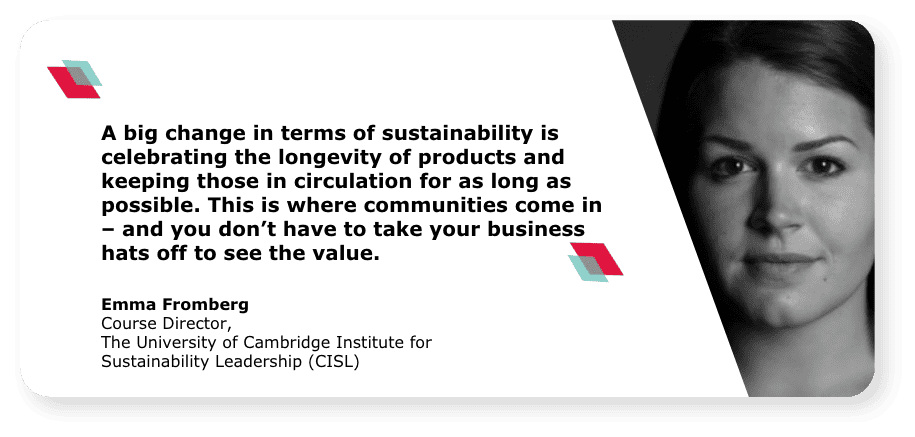
Richard Singleton, Finance & Sustainability Director at Menzies LLP, adds that smaller companies can struggle due to restraints on budget and resources.
“I think for a smaller manufacturer the challenges they're really facing are resource: what can they actually put on their supply chain? If running parallel to them is a very large business, they're not going to have much impact on the supply chain.”
Emma Fromberg, Course Director at the Cambridge Institute of Sustainability Leadership empathises with the difficulties of achieving sustainability under today’s regulations.
“It's really hard in this current economic ecosystem to thrive as a green organisation because it's cheaper to be unsustainable,” she says. “So, you need to do it with purpose.”
On a more optimistic note, she adds: “You see a lot of those smaller organisations in this space of sustainability on a local but also global level. They're convening and working together quite tightly.
“I think collaborating pre-competitively or as a business ecosystem and using what is there already is such a valuable way of actually operating as an organisation and driving change in the space of sustainability.”
Is the flexibility of small businesses a hidden advantage in the sustainability movement?
There’s a real possibility that working together with your competitors can help everyone remain more, well, competitive. Emma believes there are other benefits to seeking sustainability as a smaller firm.
“With SMEs, you also have some superpowers,” she tells the panel. “I wouldn't compare yourself to large brands because they have very different operations.
“Smaller manufacturers can add an element of diversity within the economy, and it's really important to look at using your small scale to actually diversify and contribute to that resilience. I think that's a massive opportunity in the space of sustainability.”
Rather than take the pessimistic approach, Emma sees smaller companies’ size as an advantage that carries with it great potential for change.
“I am most excited about actually driving change within that SME space. Contrary to those really large multinationals, I think SMEs have a very unique important value to the economy.”
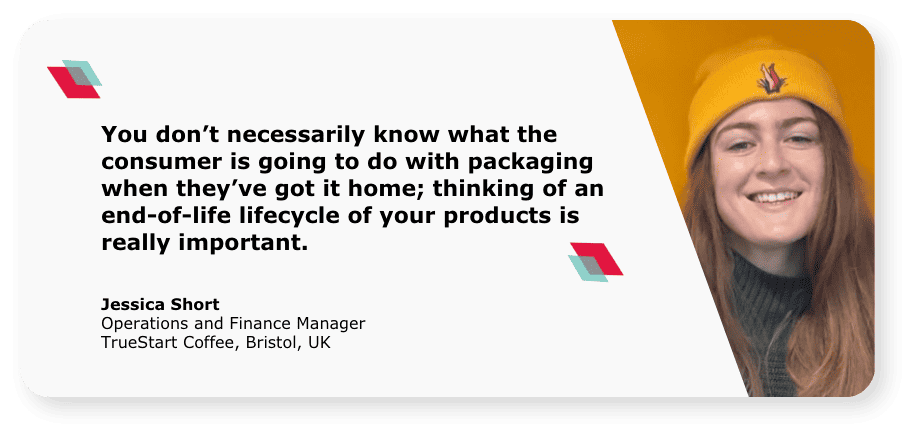
Sustainability: Where to start?
It’s easy to talk about sustainability, but words don’t equal action. And getting started is about action.
We asked our guests for their thoughts on getting your firm’s sustainability journey off on the right foot.
“One of the first things you can do as a small business is to look at where the inefficiencies lie,” says Jessica Short, Finance & Operations Manager at TrueStart Coffee. “Every business will have inefficiencies in how they're operating.
“I think by becoming more efficient, you are inherently becoming more sustainable [from] an environmental and emissions perspective.”
When it comes to getting started, Richard warns that a steady and stoic approach may be necessary to help SMEs mitigate the risks associated with supply chain sustainability.
“Ultimately, it’s a marathon, not a sprint. It's just about starting and understanding that there might be some threats out there and these threats are going to impact our business.
He adds that teamwork and support are essential in the early days.
“The problem with small businesses, as we all know, is you may have one director. Everything falls on them, so giving them a support network to help wade through the cloud is worth doing.”
Purpose-driven brands that embed sustainability into their core values should chase their mission to its root, says Emma. “How you've organized and for what purpose your business exists is going to make a massive difference in terms of how you can prioritise sustainability.”
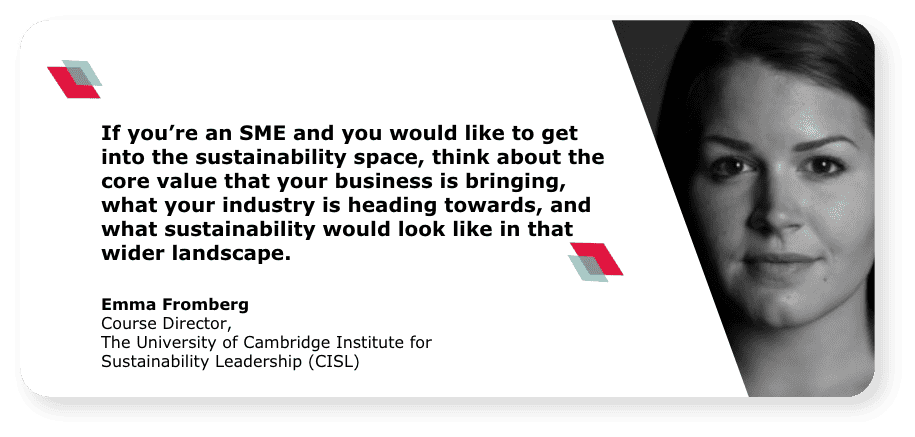
Firms still in their infancy, she adds, may benefit from a flexibility that vanishes as more shareholders get involved with the company.
“I think once you have a lot of shareholders it becomes a lot harder. Systemic conditions such as [free emissions] really do matter because you do need to justify why you're spending money on something that is for free.
“Systemic conditions are important, but you can also make changes in your organisational structure that can allow you to think more radically.”
Jess reminds us that sustainability doesn’t end when a product leaves your facilities.
“Thinking of an end-of-life lifecycle for your products is really important. You don't know what the consumer is going to do with that packaging when they've got it home.”
What is ESG, and how important is it really?
ESG stands for environmental, social, and corporate governance.
We asked our panel how they interpret these categories, and how ESG considerations can help or hinder SMEs during their sustainability journey.
As Richard explains, the environmental aspect offers a dual perspective.
“It's [about] the impact on the planet, but also the impact the changing planet is having on your business.”
He says that the social element of ESG comes down to human interaction and well-being.
“You’re looking at things like health and safety, employee engagement, welfare benefits, everything around how you treat the people inside and outside of your business.”
Finally, governance – Richard tells us – is effectively how you are operating.
“It looks at ethical trading, but it can talk about things like fines and executive remuneration, tailored to how big your business is. If you're in a small business, it can be as simple as how quickly you're paying your suppliers, how transparent you are with your reporting, [and] how responsibly you're trading.”
As a collective set of considerations, Richard sees ESG as a means of reducing long-term risk and increasing sustainability in a business.
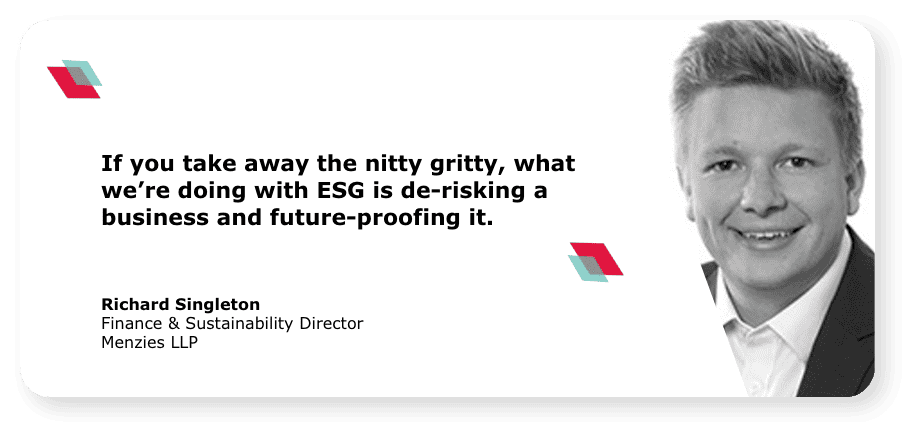
“There are cost savings and other benefits that come from just being innovative. If you take away the nitty gritty, what we're doing with ESG is de-risking a business and future-proofing it.
“When you're looking at ESG as a whole, you’re [asking] ‘What are the risks in the business, what are we not reacting to? What are we sourcing? Where are we sourcing it from? Is that going to be viable in 5, 10, 15 years?’”
Emma Fromberg warns that, while ESG can be useful for measuring a company’s progress, it’s not necessarily the key to achieving a more sustainable supply chain.
“I think it's really important to take it for what it is,” she explains. “ESG asks questions around the risk that is being posed by the changing planet onto your company. But what about your company onto the planet and society?
“It’s not asking questions [like] ‘Should this product or service or business even be here? And what does the future of this industry look like?’”
She adds that real sustainable operations begin with your core values – not a dataset.
“If you're an SME and you would like to get into the sustainability space, think about the core value that your business is bringing, what your industry is heading towards, and what sustainability would look like in that wider landscape.
“ESG may come a bit later, in my opinion, to measure that progress or how well the company performs. But to ask yourself those big sustainability questions is to also ask different questions than just about risk. It's about opportunities and the future.”
However, there’s no reason to throw the baby out with the bathwater: ESG business practices are central to B Corp Certification and align with the US & Canada’s Theory of Change.
As Jess explains, a business can align itself with ESG principles simply by focusing on real ethical and sustainable company values.
“TrueStart has, from the get-go, used common sense about making these decisions,” she says. “Our founders have always had sustainability and ethics at the core of their decision-making.
“So, when we actually carried out the [B-Corp] accreditation process, it was quite straightforward because we'd already been doing the right kind of things. We were just then documenting it.”
Jess says that ESG and B Corp Certification are helpful indicators of successful sustainability efforts.
“It's been really useful using having the B Corp assessment because it's meant that we've had processes in place about how we approach everything from new product development to finding new suppliers.”
Moving with the movement: Staying abreast of sustainability laws and regulations
So, how does one go about ensuring they’re abiding by the correct business practices – especially in a world of ever-shifting laws and regulations?
According to Richard, it doesn’t have to be as difficult as it might first seem.
“I would always recommend picking up the phone and speaking to someone. The challenge we face in sustainability is there isn't enough regulation. There's not enough pressure being put down.
“But when you're talking about challenges of thinking about ESG, it doesn't have to cost anything. Ultimately, you sit there with a SWOT analysis, and you look at your strengths with weaknesses, opportunities, and threats apply to ESG.”
The secret to getting things done, Richard says, is ensuring everyone with the power to incite change is educated and aware of what you’re doing and why.
“Ultimately, it's about knowing your business and knowing your supply chain, understanding who your stakeholders are. Awareness of your business and that wider stakeholder pool is where you need to be focusing. In the past, [we] worried about shareholders, owners of the business. Nowadays we are looking at community. That's a stakeholder.”
How to scale responsibly: Balancing growth and sustainability
In the early days, it can be simpler to incorporate sustainable practices into your operations. Fewer outputs and greater control mean there aren’t so many spinning plates to worry about.
But as a business grows in size and complexity, a sustainable supply chain – while still possible – may require extra planning and forethought.
“As you scale and as you grow, your emissions are going to be higher,” Jess says. “It's [about] finding ways in which we can easily reduce emissions, keeping on with the reporting and having discussions with experts.”
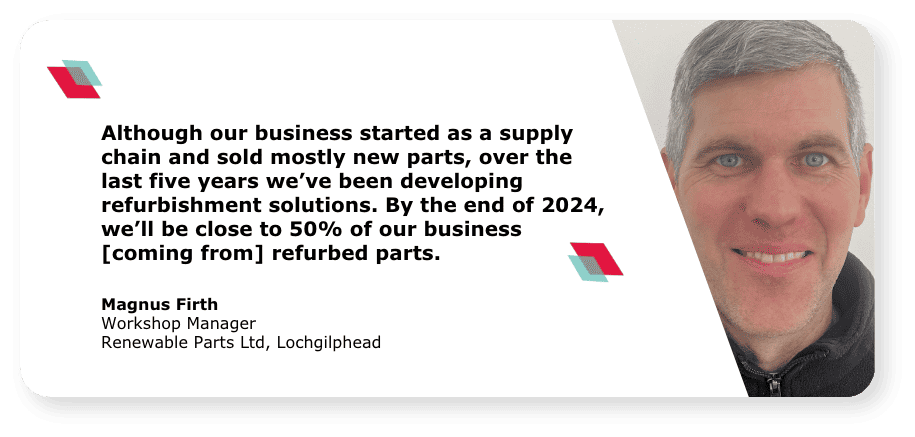
Richard points out that a restricted budget need not be a hindrance. “If resource is tight, there are some very good free resources online that you can at least start to have a play around with.”
He believes that growing responsibly largely comes down to strong communication.
“No one's mentioned communication, which I think is the most important thing. As companies are growing, their emissions are going to increase. If you’re looking at actual emissions, it's very likely the emissions are going to go up. As that business grows, it's very hard to avoid that.
“I think whether you're a customer, a competitor, a stakeholder, a shareholder… whatever you're doing, as long as a company is communicating transparently and with integrity, most people [will] respect that company.”
Emma disagrees with the sentiment that more business equals greater emissions.
“I think it's a misconception that the larger you get, the more emissions you have. It depends on what your core activities are.
“It's about making choices that suit your core activities and the type of inputs that you have, having a good reflection on what your core activities are and where you're headed, and also valuing the contribution that you're giving to the economy.”
Sustainability inspiration: Which brands are doing it well?
When it comes to sustainability in the supply chain, few are doing it quite like Renewable Parts.
Magnus explains that their company naturally evolved from a standard merchandising business selling brand-new products to having a major focus on the refurbishment of existing products.
“The major issue with the wind industry is it’s an industry that promotes itself as green energy – good for the environment,” Magnus tells the panel. “But in reality, the default for wind farms [when] a turbine breaks down is we replace new parts, and a lot of the old parts just go to scrap.
“Although our business started as a supply chain and sold mostly new parts, over the last five years we've been developing refurbishment solutions. By the end of 2024, we'll be close to 50% of our business [coming from] refurbed parts.
“All these parts for the wind turbines, they're very heavy built and you might only have one or two components broken within these parts. We can strip them down, replace parts and recirculate maybe as much as 90 or 95% of the part, whereas before 100% would be going to waste.”
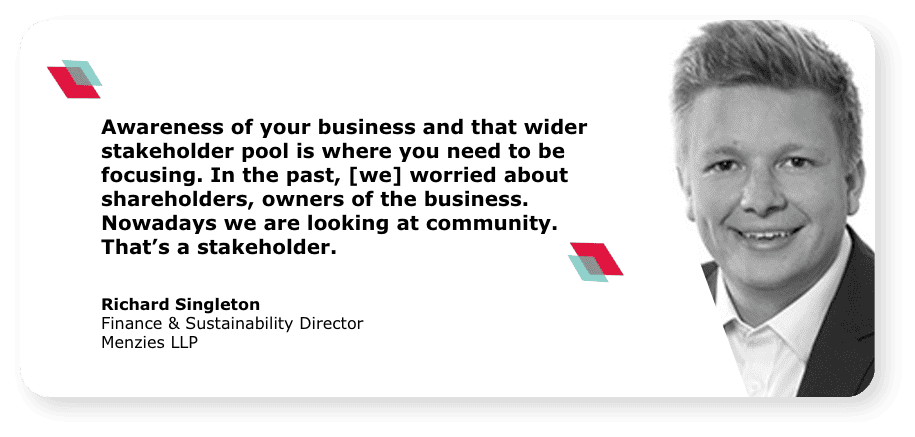
Another sustainable supply chain professional, Jessica Short shares some of the secrets and story behind TrueStart Coffee’s carbon-negative success.
“The most important thing is always choosing local suppliers and always being mindful of who we're working with. When [our director] makes decisions about choosing supplies, he always goes and meets people, and gets an idea of how they're running their business.
“We first became carbon-negative last year and it was a three-stage process. The first stage was the calculation phase where we worked with Ecofye to collect data from our entire supply chain to understand exactly where our emissions were coming from.
“Once we had that visibility over our entire supply chain, the second phase was a reduction in our emissions. We've always tried to go for the most eco-friendly packaging from the get-go, even if it hasn't necessarily been the best commercial decision.
“The third phase was offsetting. The founders picked projects that they're really excited about in the nations that we buy our coffee from. A really exciting one is the Chinchina Watershed project in Columbia. 70% of that money goes directly to farmers' silver pastoral systems and Agroforestry. And it's to support reforestation in a critical watershed to secure water supply, promote biodiversity conservation, and through that, carbon sequestration.
“We've invested in these projects to offset 120% of the carbon that we emit. We want to make sure that we're making a net positive impact on the planet after going through the reduction phase.”
Parting wisdom from a sustainability educator
To bring us home, Emma offers some final advice for sifting through what matters and what doesn’t when it comes to running a sustainable supply chain.
“Even though we love sustainability reporting, there is a moment where emissions happen or where they're not happening. There is a moment where either society or community thrives or not, and there are consequences of business decisions that are real and impacting nature and everything around us.”
She believes local sourcing and minimising single-use products are key to making a positive impact.
“We're looking at concrete examples of sustainability – I think this is where communities are really important.
“Focusing on doing more with what you have locally is the best thing to do. If we want to look at really, really big change in terms of sustainability [we need to be] celebrating the longevity of products and keeping those in circulation for as long as possible. This is where communities come in – and [you don’t] have to take your business hat off to see the value in this.
“At the end of the day, sustainability is something that either happens or doesn't. And being concrete about what it is that you would like to change allows you to break through that jargon and make it applicable for your specific company and how you would like to intervene.”
